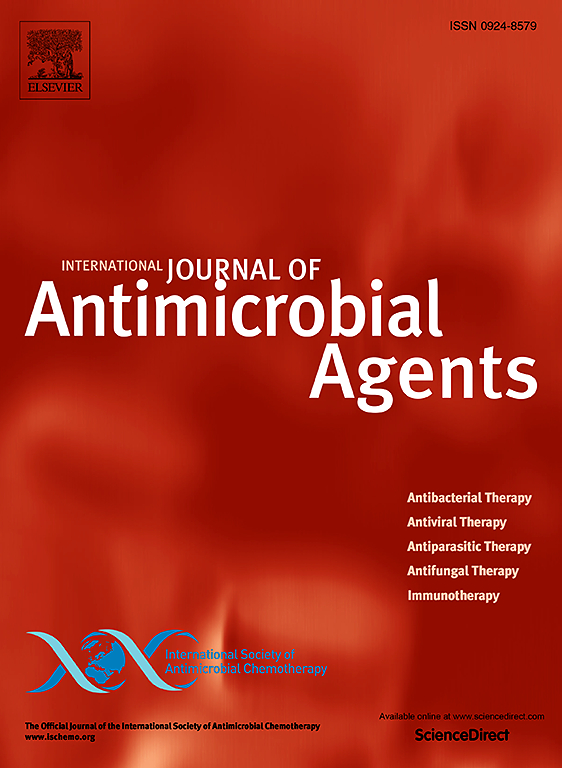Multi-omics reveals the synergistic mechanism of polymyxin B and diethyldithiocarbamate against Pseudomonas aeruginosa
IF 4.6
2区 医学
Q1 INFECTIOUS DISEASES
International Journal of Antimicrobial Agents
Pub Date : 2025-07-03
DOI:10.1016/j.ijantimicag.2025.107569
引用次数: 0
Abstract
Objectives
Resistance to polymyxin B (PMB) in carbapenem-resistant Pseudomonas aeruginosa (CRPA) has become a global issue. A promising approach to rescue PMB treatment failures is to repurpose non-antibiotics as adjuvants to enhance the efficacy of antibiotics against CRPA.
Methods
The in vitro effects of the PMB/DDC combination were assessed by microbroth dilution method, checkerboard microbroth dilution method, time-kill assay, biofilm formation inhibition assay, live/dead bacterial staining, and scanning electron microscopy. The in vivo efficacy of the PMB/DDC combination was evaluated in a PMB-resistant P. aeruginosa infection model. Comprehensive multi-omics analysis was performed to investigate the mechanism of the PMB/DDC combination.
Results
We identified that the combination of PMB and diethyldithiocarbamate (DDC) had a high synergistic effect against PMB-resistant Pseudomonas aeruginosa (P. aeruginosa) strains in vitro and significantly hindered the biofilm formation. The PMB/DDC combination was effective in treating PMB-resistant P. aeruginosa infection model in vivo, as evidenced by higher survival rates in five days and lower bacterial loads in lung tissue and liver. Comprehensive multi-omics analysis revealed that the resistance of P. aeruginosa P2550 to PMB was determined by chromosomally encoded rather than plasmid-mediated mobilized colistin resistance (MCR) clusters. The combination down-regulated the expression of the operons arnBCADTEF at 2 h, which regulate LPS modification, and the abundance of metabolites of amino sugars and nucleotide sugars related to Lipid A biosynthesis and Lipid A modification were significantly perturbed. The Gac/Rsm pathway, quorum sensing (QS) system, cAMP/Vfr signalling, and c-di-GMP signalling, which are pathways associated with biofilm formation, were significantly inhibited within the first 4 h. In addition, the PMB/DDC combination significantly disturbed metabolic pathways, including arginine biosynthesis, the tricarboxylic acid cycle (TCA), and nucleotide metabolism. Notably, PMB alone, DDC alone, and the combination disrupted membrane-associated glycerophospholipid metabolism.
Conclusions
The study highlights the potential of the PMB/DDC combination for treating PMB-resistant P. aeruginosa infections and elucidates the synergistic bactericidal mechanism of the combination through multi-omics methods.

多粘菌素B与二乙基二硫代氨基甲酸酯对铜绿假单胞菌的协同作用机制。
耐碳青霉烯铜绿假单胞菌(Pseudomonas aeruginosa, CRPA)对多粘菌素B (PMB)的耐药性已成为一个全球性问题。挽救PMB治疗失败的一个有希望的方法是重新使用非抗生素作为佐剂来增强抗生素对CRPA的疗效。在体外实验中,我们发现PMB与二乙基二硫代氨基甲酸酯(DDC)联合使用对PMB耐药的铜绿假单胞菌(P. aeruginosa)具有较高的协同作用,并显著阻碍了生物膜的形成。PMB/DDC联合治疗PMB耐药铜绿假单胞菌感染模型有效,5天生存率较高,肺组织和肝脏细菌负荷较低。综合多组学分析表明,P. aeruginosa P2550对PMB的耐药性是由染色体编码而不是质粒介导的动员粘菌素抗性(MCR)簇决定的。联合用药使调控LPS修饰的操纵子arnBCADTEF在2 h的表达下调,与脂质A生物合成和脂质A修饰相关的氨基糖和核苷酸糖的代谢物丰度受到显著干扰。与生物膜形成相关的Gac/Rsm通路、群体感应(QS)系统、cAMP/Vfr信号通路和c-di-GMP信号通路在前4小时内被显著抑制。此外,PMB/DDC组合显著干扰了代谢通路,包括精氨酸生物合成、三羧酸循环(TCA)和核苷酸代谢。值得注意的是,PMB单独,DDC单独和联合破坏膜相关的甘油磷脂代谢。本研究强调了PMB/DDC联合治疗耐PMB铜绿假单胞菌感染的潜力,并通过多组学方法阐明了该联合的协同杀菌机制。
本文章由计算机程序翻译,如有差异,请以英文原文为准。
求助全文
约1分钟内获得全文
求助全文
来源期刊
CiteScore
21.60
自引率
0.90%
发文量
176
审稿时长
36 days
期刊介绍:
The International Journal of Antimicrobial Agents is a peer-reviewed publication offering comprehensive and current reference information on the physical, pharmacological, in vitro, and clinical properties of individual antimicrobial agents, covering antiviral, antiparasitic, antibacterial, and antifungal agents. The journal not only communicates new trends and developments through authoritative review articles but also addresses the critical issue of antimicrobial resistance, both in hospital and community settings. Published content includes solicited reviews by leading experts and high-quality original research papers in the specified fields.

 求助内容:
求助内容: 应助结果提醒方式:
应助结果提醒方式:


